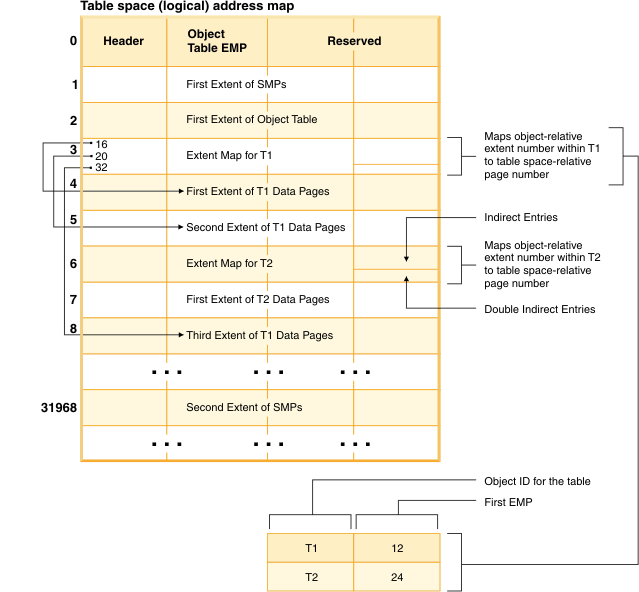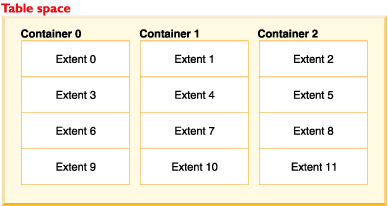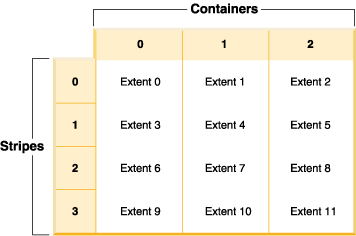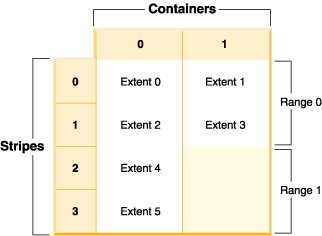A table space map is the database manager's internal representation of a DMS table space that describes the logical to physical conversion of page locations in a table space. This topic describes why a table space map is useful, and where the information in a table space map comes from.
In a partitioned database, pages in a DMS table space are logically numbered from 0 to (N-1), where N is the number of usable pages in the table space.
The pages in a DMS table space are grouped into extents, based on the extent size, and from a table space management perspective, all object allocation is done on an extent basis. That is, a table might use only half of the pages in an extent but the whole extent is considered to be in use and owned by that object. By default, one extent is used to hold the container tag, and the pages in this extent cannot be used to hold data. However, if the DB2_USE_PAGE_CONTAINER_TAG registry variable is turned on, only one page is used for the container tag.
Figure 1 shows the logical address map for a DMS table space.

Within the table space address map there are two types of map pages: extent map pages (EMP) and space map pages.
The object table is an internal relational table that maps an object identifier to the location of the first EMP extent in the table. This EMP extent, directly or indirectly, maps out all extents in the object. Each EMP contains an array of entries. Each entry maps an object-relative extent number to a table space-relative page number where the object extent is located. Direct EMP entries directly map object-relative addresses to table space-relative addresses. The last EMP page in the first EMP extent contains indirect entries. Indirect EMP entries map to EMP pages which then map to object pages. The last 16 entries in the last EMP page in the first EMP extent contain double-indirect entries.
The extents from the logical table-space address map are striped in round-robin order across the containers associated with the table space.
Because space in containers is allocated by extent, pages that do not make up a full extent will not be used. For example, if you have a 205-page container with an extent size of 10, one extent will be used for the tag, 19 extents will be available for data, and the five remaining pages are wasted.
If a DMS table space contains a single container, the conversion from logical page number to physical location on disk is a straightforward process where pages 0, 1, 2, are located in that same order on disk.
It is also a fairly straightforward process when there is more than one container and each of the containers is the same size. The first extent in the table space, containing pages 0 to (extent size - 1), is located in the first container, the second extent will be located in the second container, and so on. After the last container, the process repeats starting back at the first container. This cyclical process keeps the data balanced.
For table spaces containing containers of different sizes, a simple approach that proceeds through each container in turn cannot be used as it will not take advantage of the extra space in the larger containers. This is where the table space map comes in - it dictates how extents are positioned within the table space, ensuring that all of the extents in the physical containers are available for use.
Example 1:
There are 3 containers in a table space, each container contains 80 usable pages, and the extent size for the table space is 20. Each container therefore has 4 extents (80 / 20) for a total of 12 extents. These extents are located on disk as shown in Figure 2.

Range Stripe Stripe Max Max Start End Adj. Containers
Number Set Offset Extent Page Stripe Stripe
[0] [0] 0 11 239 0 3 0 3 (0, 1, 2)A range is the piece of the map in which a contiguous range of stripes all contain the same set of containers. In Example 1, all of the stripes (0 to 3) contain the same set of 3 containers (0, 1, and 2) and therefore this is considered a single range.
The headings in the table space map are Range Number, Stripe Set, Stripe Offset, Maximum extent number addressed by the range, Maximum page number addressed by the range, Start Stripe, End Stripe, Range adjustment, and Container list. These will be explained in more detail for Example 2.
This table space can also be diagrammed as shown in Figure 3, in which each vertical line corresponds to a container, each horizontal line is called a stripe, and each cell number corresponds to an extent.

Example 2:
There are two containers in the table space: the first is 100 pages in size, the second is 50 pages in size, and the extent size is 25. This means that the first container has four extents and the second container has two extents. The table space can be diagrammed as shown in Figure 4.

Range Stripe Stripe Max Max Start End Adj. Containers
Number Set Offset Extent Page Stripe Stripe
[0] [0] 0 3 99 0 1 0 2 (0, 1)
[1] [0] 0 5 149 2 3 0 1 (0)There are four extents in the first range, and therefore the maximum extent number addressed in this range (Max Extent) is 3. Each extent has 25 pages and therefore there are 100 pages in the first range. Since page numbering also starts at 0, the maximum page number addressed in this range (Max Page) is 99. The first stripe (Start Stripe) in this range is 0 and the last stripe (End Stripe) in the range is stripe 1. There are two containers in this range and those are 0 and 1. The stripe offset is the first stripe in the stripe set, which in this case is 0 because there is only one stripe set. The range adjustment (Adj.) is an offset used when data is being rebalanced in a table space. (A rebalance might occur when space is added or dropped from a table space.) When a rebalance is not taking place, this is always 0.
There are two extents in the second range and because the maximum extent number addressed in the previous range is 3, the maximum extent number addressed in this range is 5. There are 50 pages (2 extents * 25 pages) in the second range and because the maximum page number addressed in the previous range is 99, the maximum page number addressed in this range is 149. This range starts at stripe 2 and ends at stripe 3.